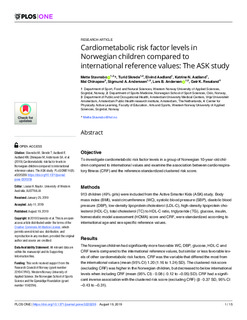| dc.contributor.author | Stavnsbo, Mette | |
| dc.contributor.author | Skrede, Turid | |
| dc.contributor.author | Aadland, Eivind | |
| dc.contributor.author | Aadland, Katrine Nyvoll | |
| dc.contributor.author | Chinapaw, Mai | |
| dc.contributor.author | Anderssen, Sigmund Alfred | |
| dc.contributor.author | Andersen, Lars Bo | |
| dc.contributor.author | Resaland, Geir Kåre | |
| dc.coverage.spatial | Norway | nb_NO |
| dc.date.accessioned | 2019-10-30T08:57:28Z | |
| dc.date.available | 2019-10-30T08:57:28Z | |
| dc.date.created | 2019-09-19T12:00:33Z | |
| dc.date.issued | 2019 | |
| dc.identifier.citation | Stavnsbo, M., Skrede, T., Aadland, E., Aadland, K. N., Chinapaw, M., Anderssen, S. A., … Resaland, G. K. (2019). Cardiometabolic risk factor levels in Norwegian children compared to international reference values: The ASK study. Plos One, 14(8). | nb_NO |
| dc.identifier.issn | 1932-6203 | |
| dc.identifier.uri | http://hdl.handle.net/11250/2625310 | |
| dc.description.abstract | Objective To investigate cardiometabolic risk factor levels in a group of Norwegian 10-year-old children compared to international values and examine the association between cardiorespiratory fitness (CRF) and the reference-standardized clustered risk score. Methods 913 children (49% girls) were included from the Active Smarter Kids (ASK) study. Body mass index (BMI), waist circumference (WC), systolic blood pressure (SBP), diastolic blood pressure (DBP), low-density lipoprotein cholesterol (LDL-C), high-density lipoprotein cholesterol (HDL-C), total cholesterol (TC) to HDL-C ratio, triglyceride (TG), glucose, insulin, homeostatic model assessment (HOMA) score and CRF, were standardized according to international age-and sex-specific reference values. Results The Norwegian children had significantly more favorable WC, DBP, glucose, HDL-C and CRF levels compared to the international reference values, but similar or less favorable levels of other cardiometabolic risk factors. CRF was the variable that differed the most from the international values (mean (95% CI) 1.20 (1.16 to 1.24) SD). The clustered risk score (excluding CRF) was higher in the Norwegian children, but decreased to below international levels when including CRF (mean (95% CI) - 0.08 (- 0.12 to –0.05) SD). CRF had a significant inverse association with the clustered risk score (excluding CRF) (β - 0.37 SD, 95% CI –0.43 to –0.31). Conclusions Norwegian children have substantially higher CRF levels than international standards, and including CRF in clustered risk scores reduces overall risk in Norwegian children below that of international levels. CRF is associated with improved cardiometabolic health in children. | nb_NO |
| dc.language.iso | eng | nb_NO |
| dc.publisher | PLoS | nb_NO |
| dc.rights | Navngivelse 4.0 Internasjonal | * |
| dc.rights.uri | http://creativecommons.org/licenses/by/4.0/deed.no | * |
| dc.title | Cardiometabolic risk factor levels in Norwegian children compared to international reference values: The ASK study | nb_NO |
| dc.type | Journal article | nb_NO |
| dc.type | Peer reviewed | nb_NO |
| dc.description.version | publishedVersion | nb_NO |
| dc.rights.holder | © 2019 Stavnsbo et al. | nb_NO |
| dc.subject.nsi | VDP::Medisinske Fag: 700::Idrettsmedisinske fag: 850 | nb_NO |
| dc.source.pagenumber | 1-15 | nb_NO |
| dc.source.volume | 14 | nb_NO |
| dc.source.journal | PLOS ONE | nb_NO |
| dc.source.issue | 8 | nb_NO |
| dc.identifier.doi | 10.1371/journal.pone.0220239 | |
| dc.identifier.cristin | 1726661 | |
| dc.relation.project | Norges forskningsråd: 221047/F40 | nb_NO |
| dc.relation.project | Gjensidigestiftelsen: 1042294 | nb_NO |
| cristin.unitcode | 203,10,1,0 | |
| cristin.unitcode | 203,10,0,0 | |
| cristin.unitname | Institutt for idrett, kosthald og naturfag | |
| cristin.unitname | Fakultet for lærarutdanning, kultur og idrett | |
| cristin.ispublished | true | |
| cristin.fulltext | original | |
| cristin.qualitycode | 1 | |

